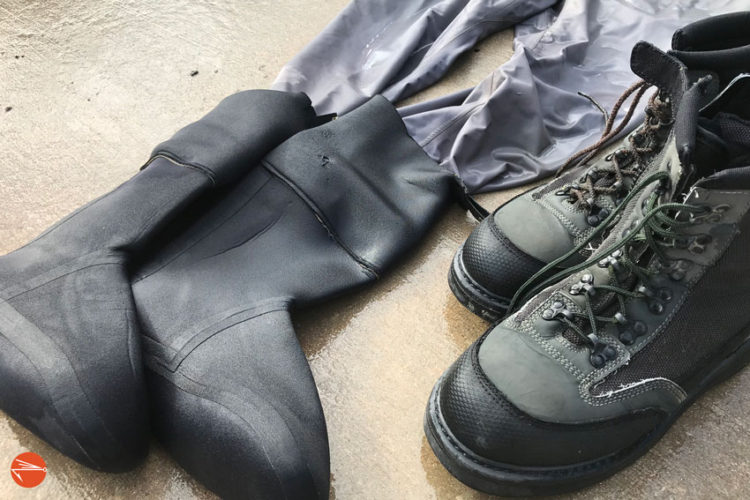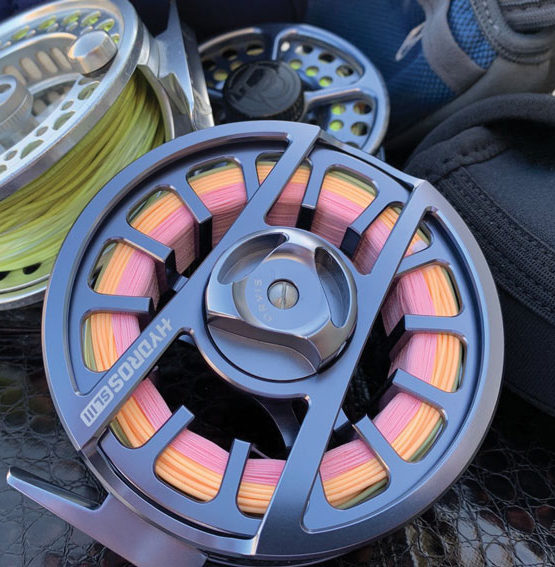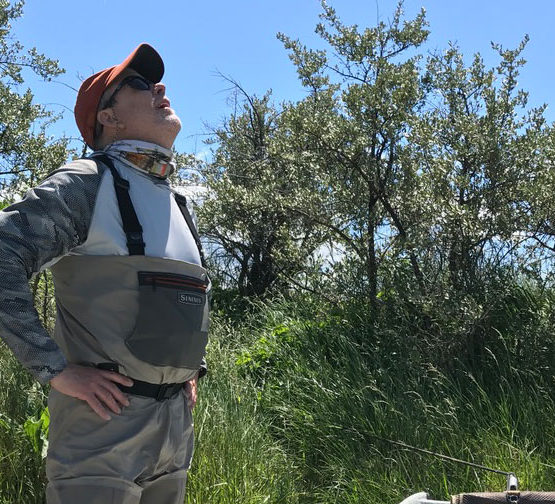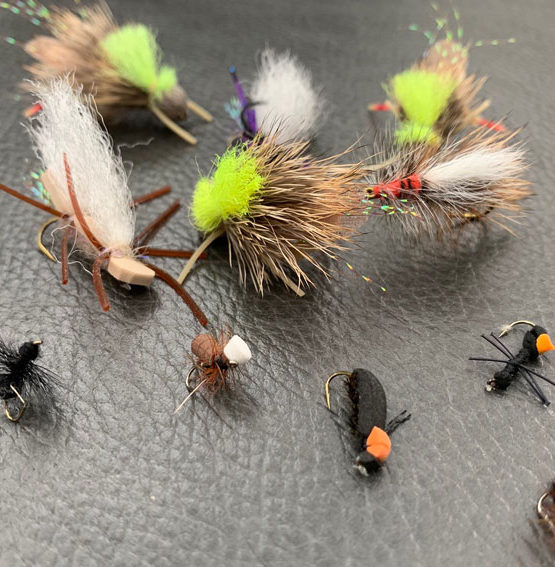Looking for some tips on how to take care of your waders?
Waders are one of the most important pieces in the arsenal of a fly fisherman, and they don’t come cheap, so it’s essential to take good care of them and make them last as long as possible.
Whether you’re new to fly fishing or have lots of experience under your belt, it’s important to learn how to keep your breathable waders in excellent condition.
In this post, we’ll go over the top 10 essential tips to take care of your waders so you get the best out of them for seasons to come.
Disclaimer: This post may contain affiliate links, meaning we will receive a small commission (at no cost to you) if you click through and make a purchase.1. Keep Your Waders Clean
Cleaning your waders properly is the best way to keep them in tip-top shape over the years. Besides obvious reasons such as keeping the waders hygienic and smelling nice, cleaning them regularly also helps with the breathability of the fabric and enhances the performance.
At minimum, we recommend thoroughly spraying off your waders (and boots) with a hose after every use. This will not only keep your equipment clean, but it will help to eliminate the the spread of any invasive species from one body of water to another. Beyond that, you should deep clean your breathable waders at least once a season, and especially before doing any repairs.
You can wash waders in a washing machine or by hand, depending on your preference and the care instructions on the label. Either way, there are a couple of important things to remember.
Machine Washing
- Only ever use a front load washer as the agitators and impellers in top load washers may tear your waders.
- Always use a cold water program with a cold rinse.
- Take off any loose parts, such as wading belts, before throwing the waders into the washing machine.
- Only use detergents that are specifically designed for waterproof wader fabric. Steer clear from powder detergents.
- Do not, under any circumstances, use any fabric softener.
- Always check the care instructions provided by the manufacturer to check whether the waders can be washed in a washing machine.
Hand Washing
- Scrub the waders lightly with a soft brush if they are particularly dirty.
- Soak the waders in cool water in which you dissolved the washing solution.
- Never use harsh detergents and stay away from powder detergents.
- Rinse the waders thoroughly with cold water, making sure no detergent remains on them.
Important Note: Whether you spray them off with a hose, hand wash, or machine wash your waders, we highly recommend you turn them inside out and hang them up to dry overnight. This small step will help keep your waders clean, mold-free, and in great shape for a really long time. Oh, and if machine washing your waders makes you a little nervous, we recommend erring on the side of caution and exclusively hand-washing.
2. Dry Your Waders Completely
Drying the waders completely before storing them is critical because otherwise, mold will likely form on them.
AS you probably know, mold doesn’t need a lot of moisture to grow. Just a partially damp area on your waders is enough for microscopic spores to begin to grow. Mold can destroy perfectly good waders, not just by breaking the breathability of the fabric, but also by causing damage to the membrane, which in time will cause the waders to leak. Not to mention that no one wants to deal with the smell of mold or mildew.
Additionally, dampness can also cause the tape on the seams of the waders to loosen and fade (which pretty much defeats the whole purpose of waders).
So, how do you dry waders?
Air drying is the best solution for drying out waders, but some fabrics are also suitable for tumble drying. Most technical fabrics can be dried in a tumble dryer, but you should always check the care instructions provided by the manufacturer. Additionally, you should turn your waders inside out and hang them up to dry overnight. This will protect the inner lining of your waders and help to keep them in tip-top shape.
3. Apply a Direct Water Repellant
The waterproof coating on waders may start to fail after a while, even if you take proper care of them. That’s not a reason to panic, though, as you can solve the problem by applying a direct water repellant.
To apply the solution, hand your waders up and spray the water repellent on them. You don’t have to spray on the rubber or neoprene parts — just focus on the areas that have a waterproof coating.
Next, activate the water repellant treatment by using a hairdryer while the waders are still damp.
4. Transport Your Waders Properly
When transporting waders, it’s often not possible to keep them lying flat, so we suggest you roll them instead of folding to avoid the forming of creases. No matter how gently you fold waders, there’s always going to be pressure applied on the materials and seams, which will eventually result in leaks.
Improper transport and storage may void the warranty of the waders, so this is an area that you need to be very careful about. Try not to let your waders sit in direct sunlight before or after using them, and absolutely never leave them wet and dirty in your car overnight.
If you’re looking for a good way to store and transport your waders, we recommend the Simms Taco Wader Bag. The breathable mesh will help to keep your waders dry/mold-free. Plus, when they are fully unzipped, they make for a great, pebble-free, place to stand when putting on your waders.
5. Store Your Waders Carefully
When you’re not using the waders, it’s best to store them flat or hanging. Whenever possible, it’s best to avoid folding your waders, because this may cause stress along the seams and creases, which, over time, may result in tears or cracks.
When storing your waders for winter, make sure they are completely clean and dry, and be sure to store them indoors, away from the elements. Though, if you have to store them in a shed, or your garage, make sure you don’t leave them in a box on the floor. Why? Well, let’s just say waders make a nice home for mice during the cold winter months.
6. Repair Small Punctures
Nobody likes to experience a puncture in their waders, but if that happens to you, it’s important to act immediately. To fix a small hole and avoid leaks, use a sealant recommended by the manufacturer.
Apply it in a thin coat on the interior of the waders, making sure you cover not only the puncture, but also the area around it so the sealant attaches to the fabric.
After applying the sealant over the problem areas, hang them to dry still inside out and allow the sealant to cure for a minimum of 12 to 24 hours.
7. Repair Tears / Cuts in Your Waders
Tears and cuts in your waders are more difficult to repair than small punctures, mostly because the process requires the use of a patch. Most manufacturers include a swatch of fabric you can use to repair tears, but if you don’t have one or you need more of them, you can generally purchase them at your local fly shop.
In order to fix a tear, start by pulling the cut pieces together and apply a liberal amount of sealant to the affected area, and wait until it becomes tacky. Place a patch of material over the tear, making sure it’s about 1.5X larger than the tear. Press firmly until it sticks well to the sealant. This is generally enough to fix the tear, but you can also apply some additional sealant around the edges of the patch for extra peace of mind.
8. Rinse Off Saltwater
If you’re using the waders in salt water, it’s important to thoroughly rinse them out with fresh water after each use. Saltwater is indeed extremely corrosive and will affect the integrity and breathability of the fabric, thus shortening the lifespan of the waders. You should rinse them with fresh water even if you don’t wash them immediately with detergent. As always, make sure you allow the waders to dry out completely before storing them.
9. Cut Your Toe Nails
This might seem like an odd tip, but if you want to protect the inside of your waders and avoid grinding away the inside region of the toes, cut your toenails. Long toenails can indeed damage the interior of the waders, especially if the pair is not very well fitted for you.
Which leads us to another tip — always buy waders that fit you well and make sure there’s a reasonable amount of room for your toes to move comfortably. Don’t just buy a pair that looks like it will fit based on your body shape; instead, consider your foot size as well to feel comfortable on all fronts.
10. Always Follow the Manufacturer’s Care Instructions
While the advice we gave in the tips above is generally applicable to most waders, it’s always important to read the instructions provided by the manufacturer so you can be sure you take good care of your specific waders. Some models are suitable for tumble drying, for example, whereas others aren’t, so it’s important to follow all instructions properly so you don’t accidentally damage your waders.
Waders are one of the most important pieces of fly fishing equipment you can own, so it’s worth taking a couple extra minutes to check the manufacturer’s care instructions.
Final Thoughts
Quality waders can last for years, provided you take good care of them.
To get the most life out of your waders, make sure you rinse them off and dry them after every use. Additionally, be sure to store them correctly and repair any punctures, cracks or tears. Oh, and don’t forget to cut your toenails.
If you follow these tips, along with the manufacturer’s care instructions, you waders will undoubtedly serve you well for a long, long time.










